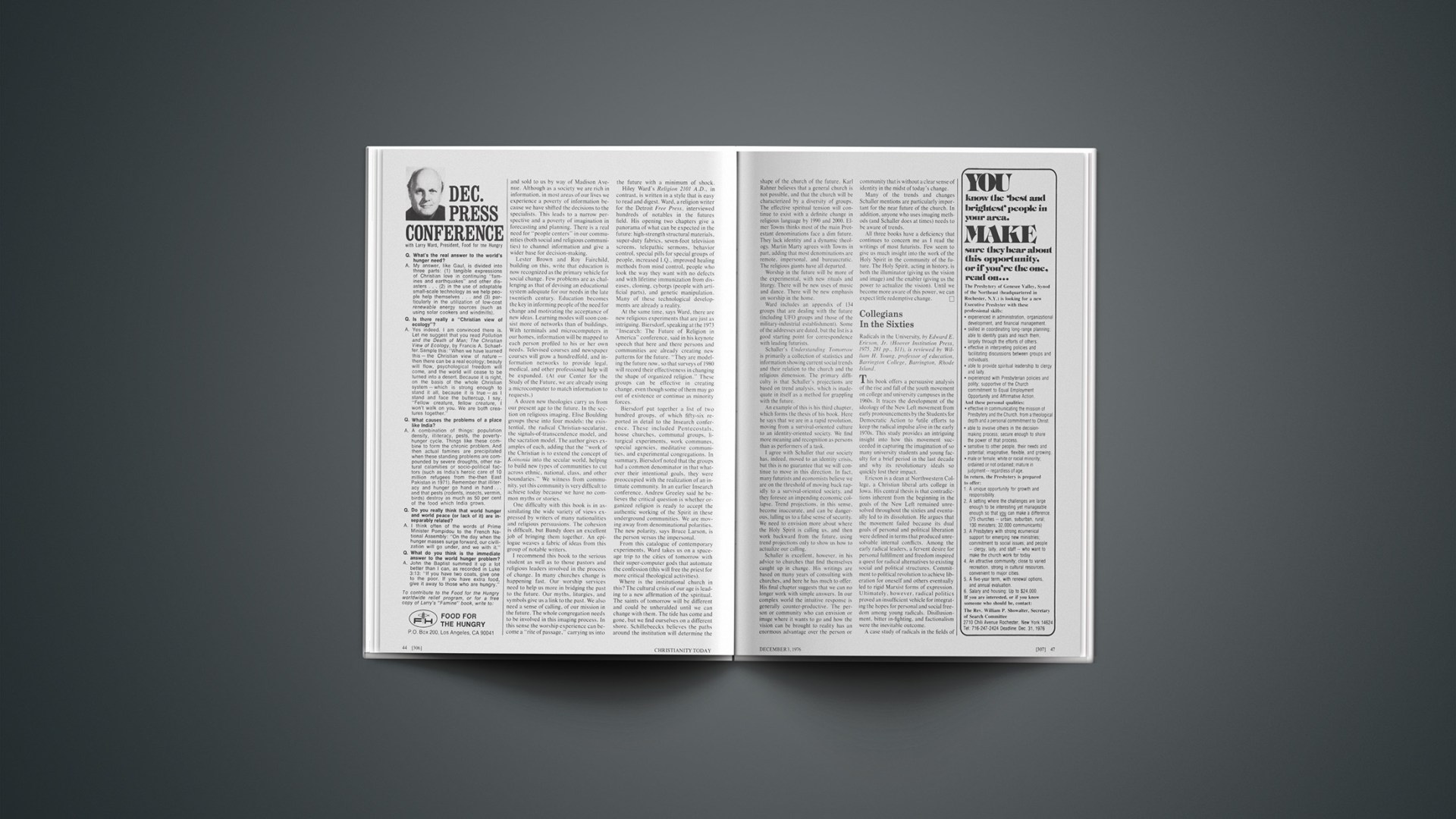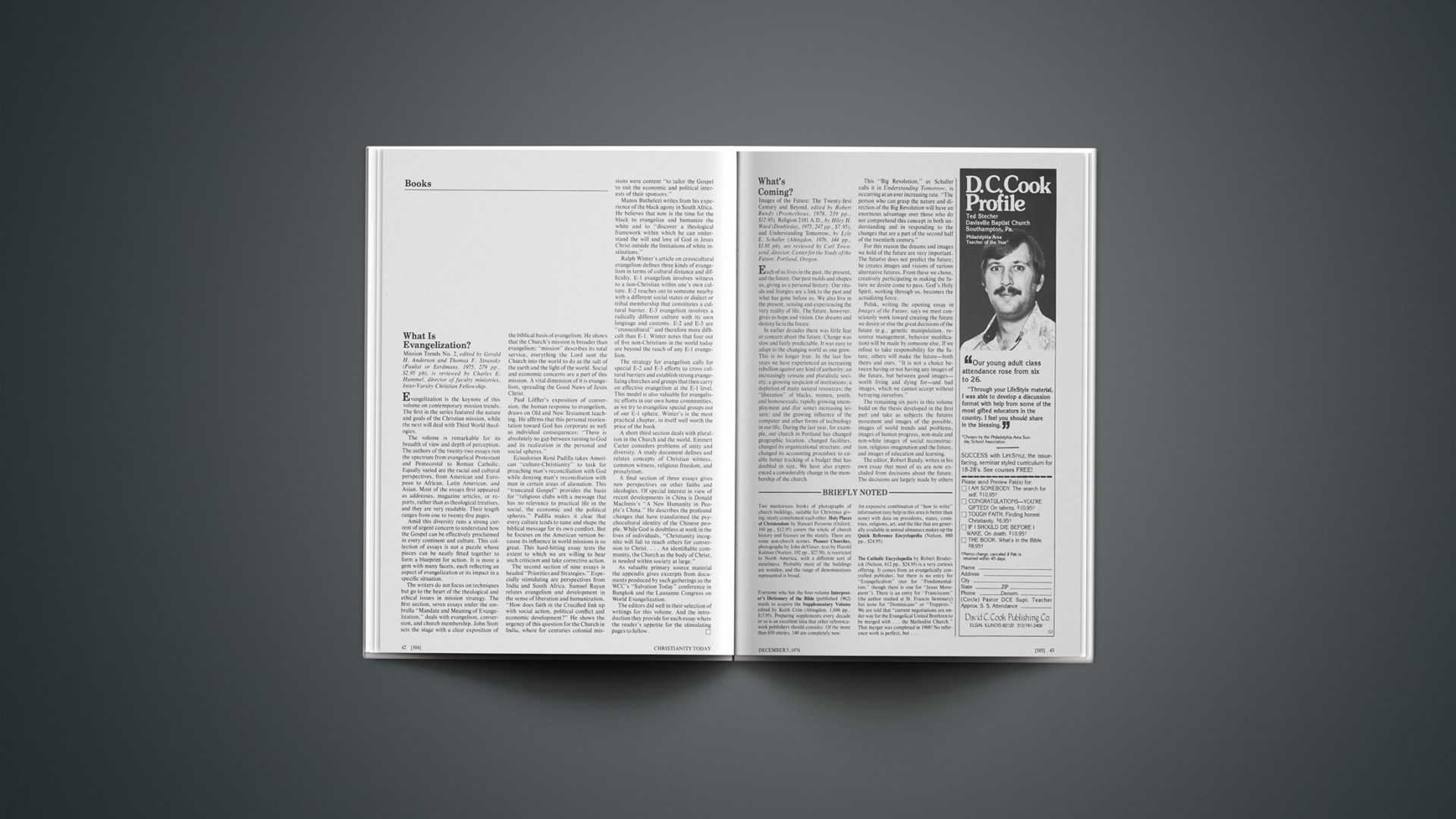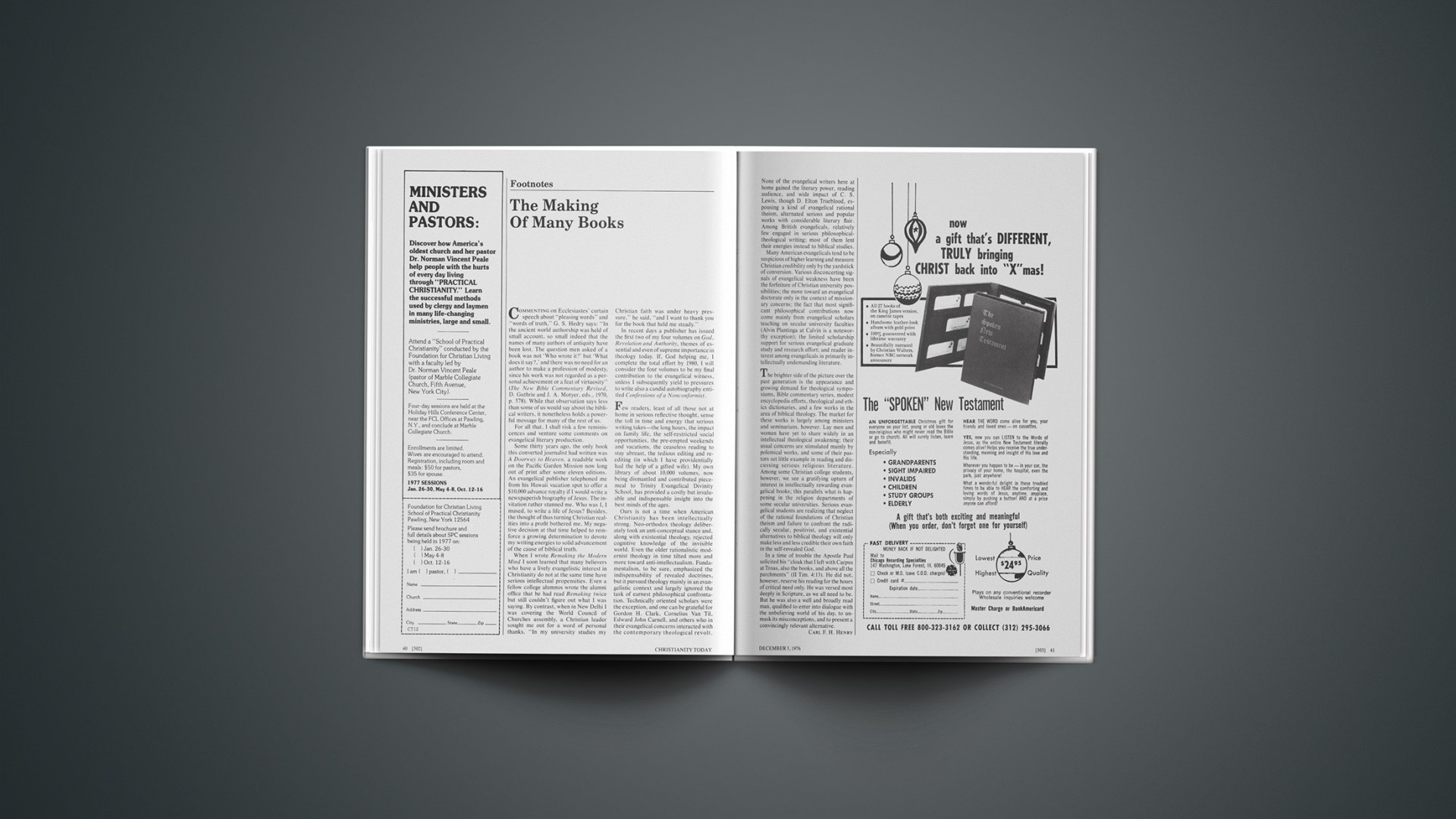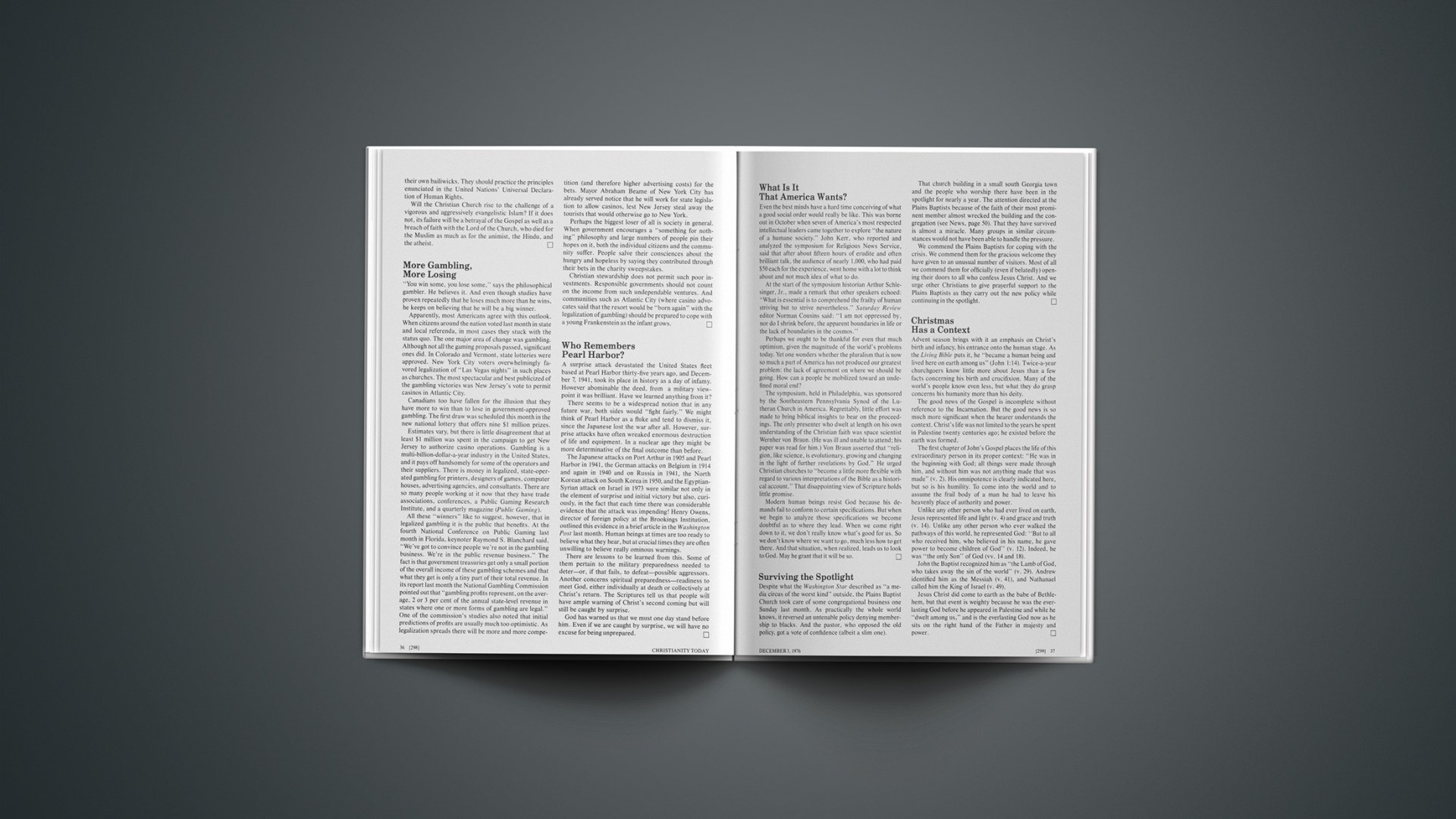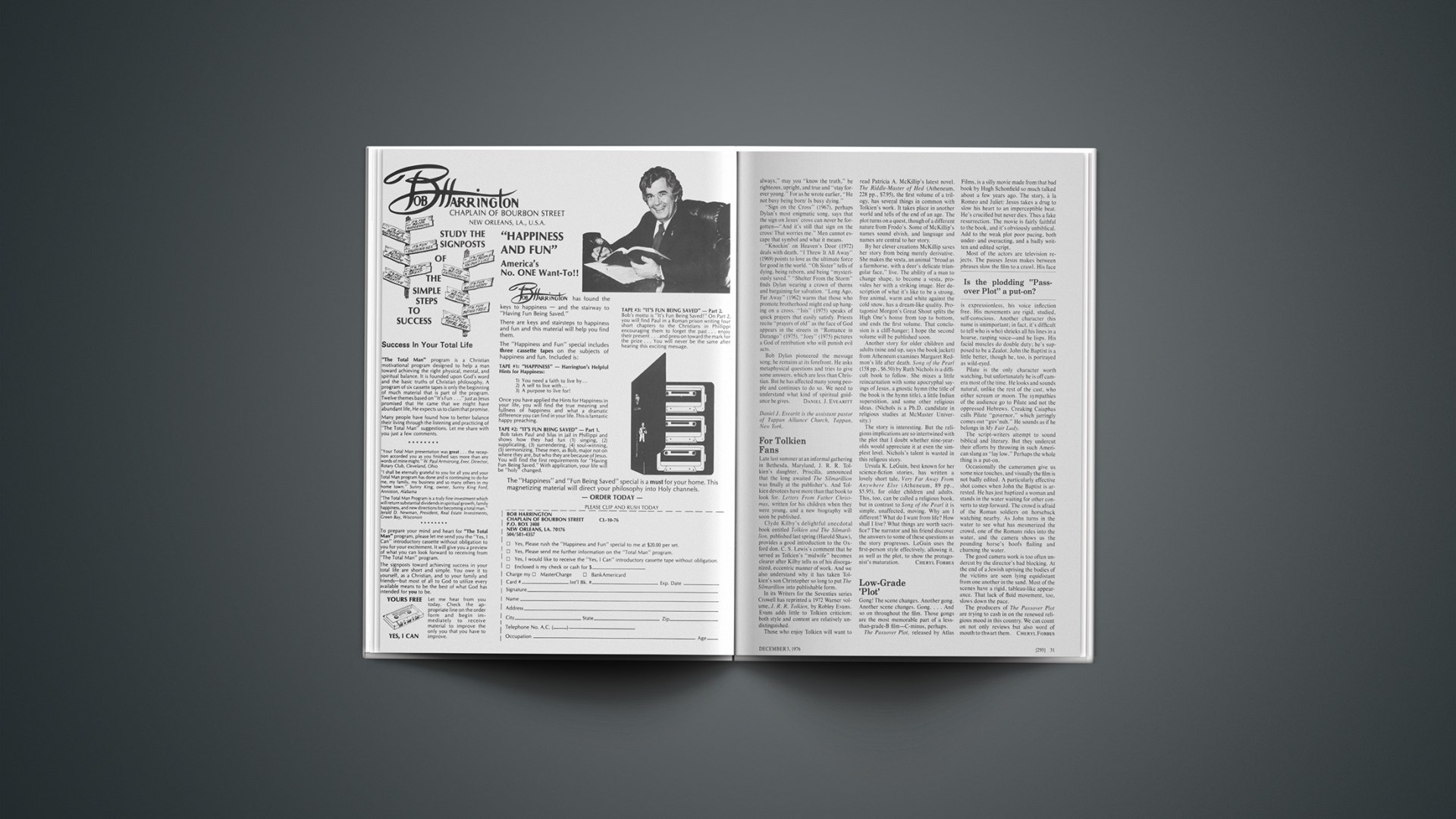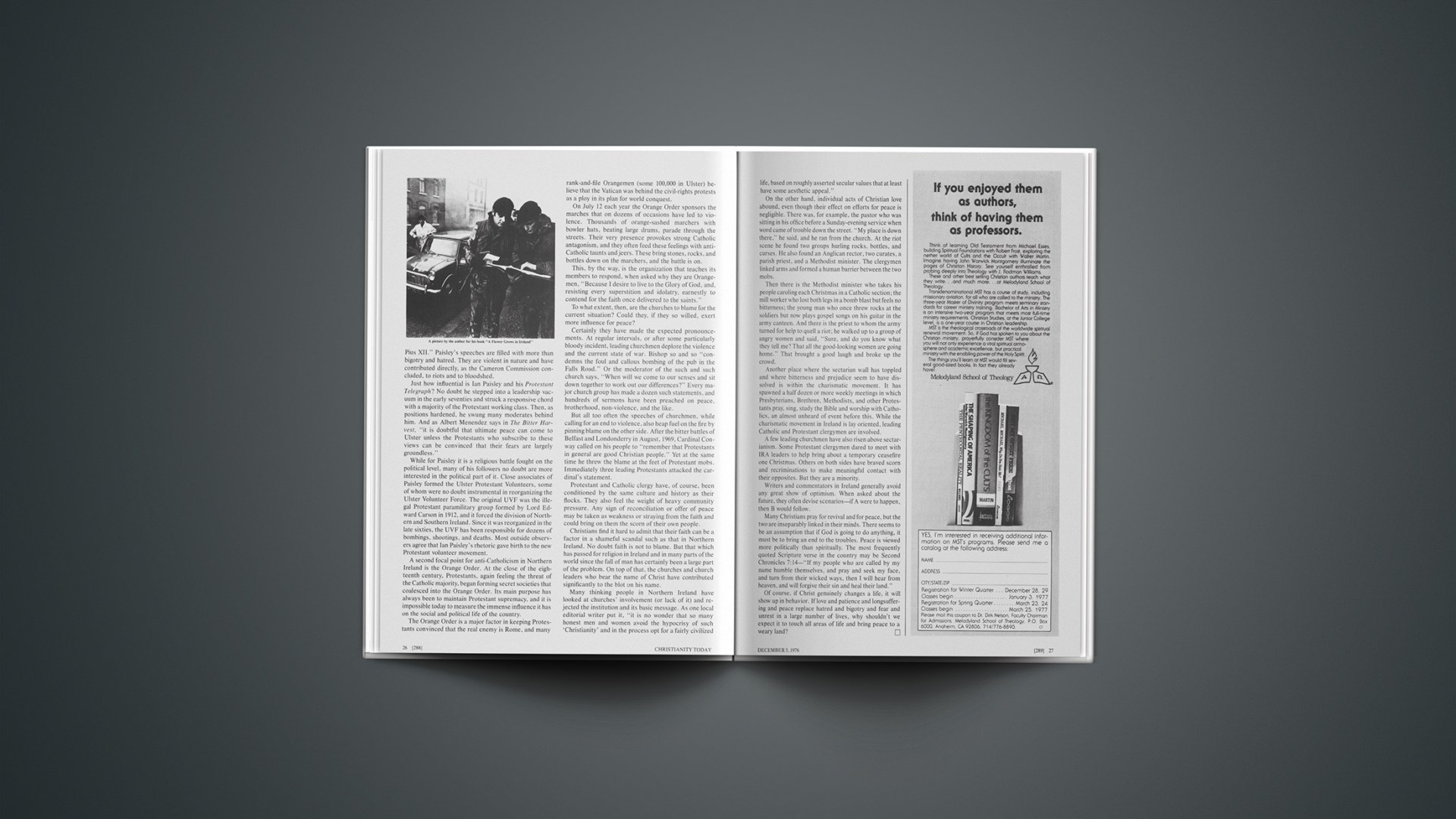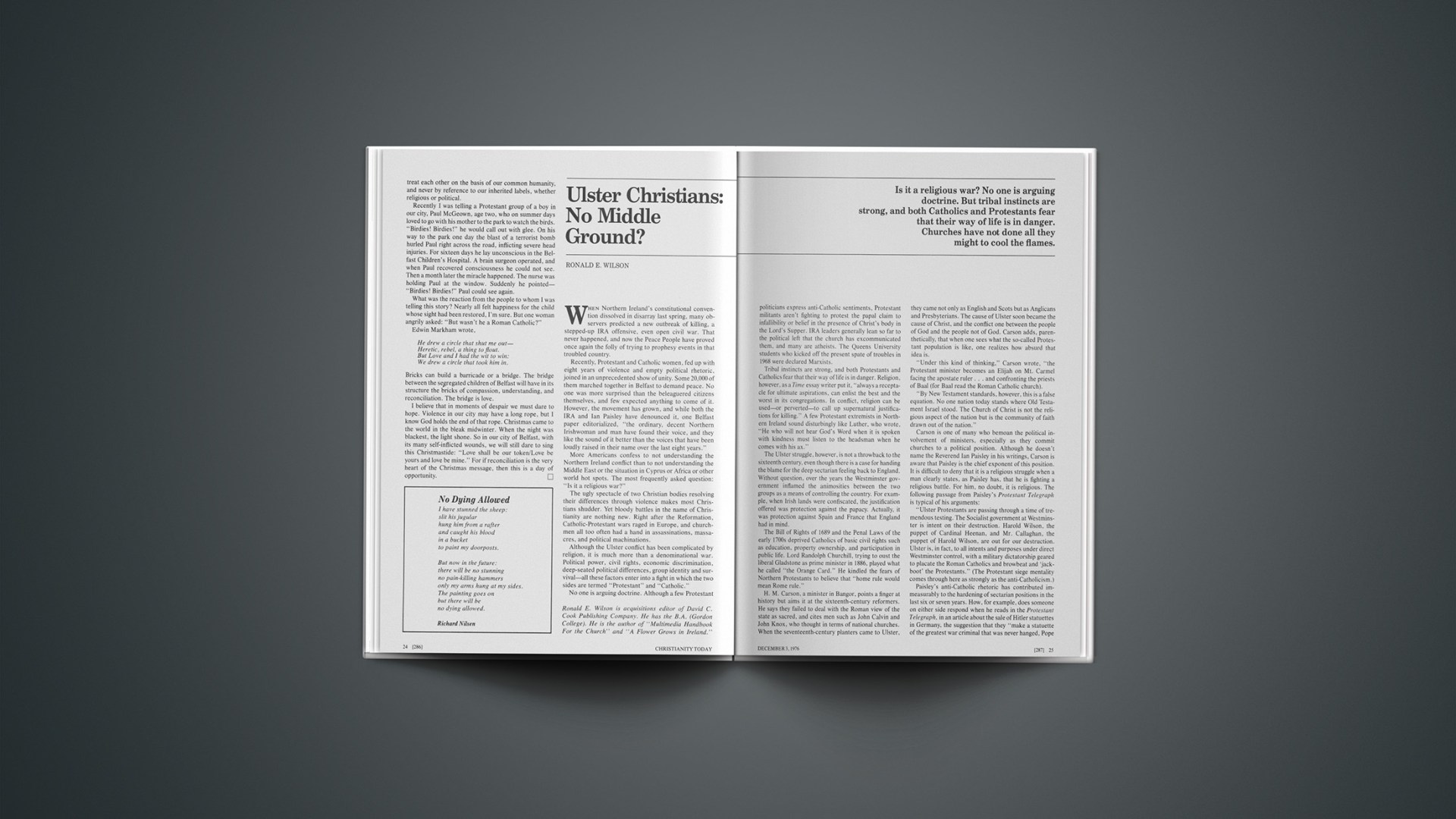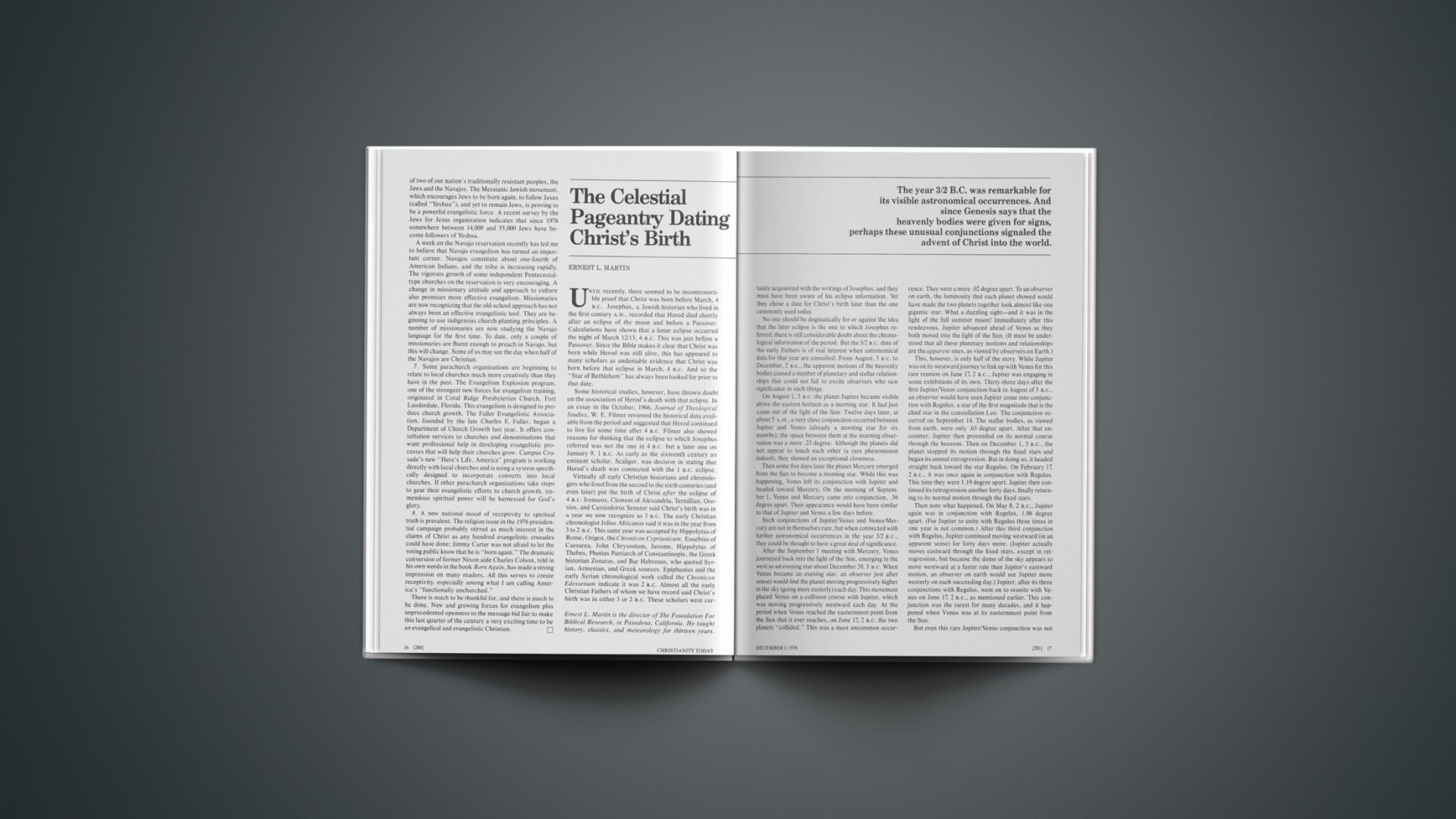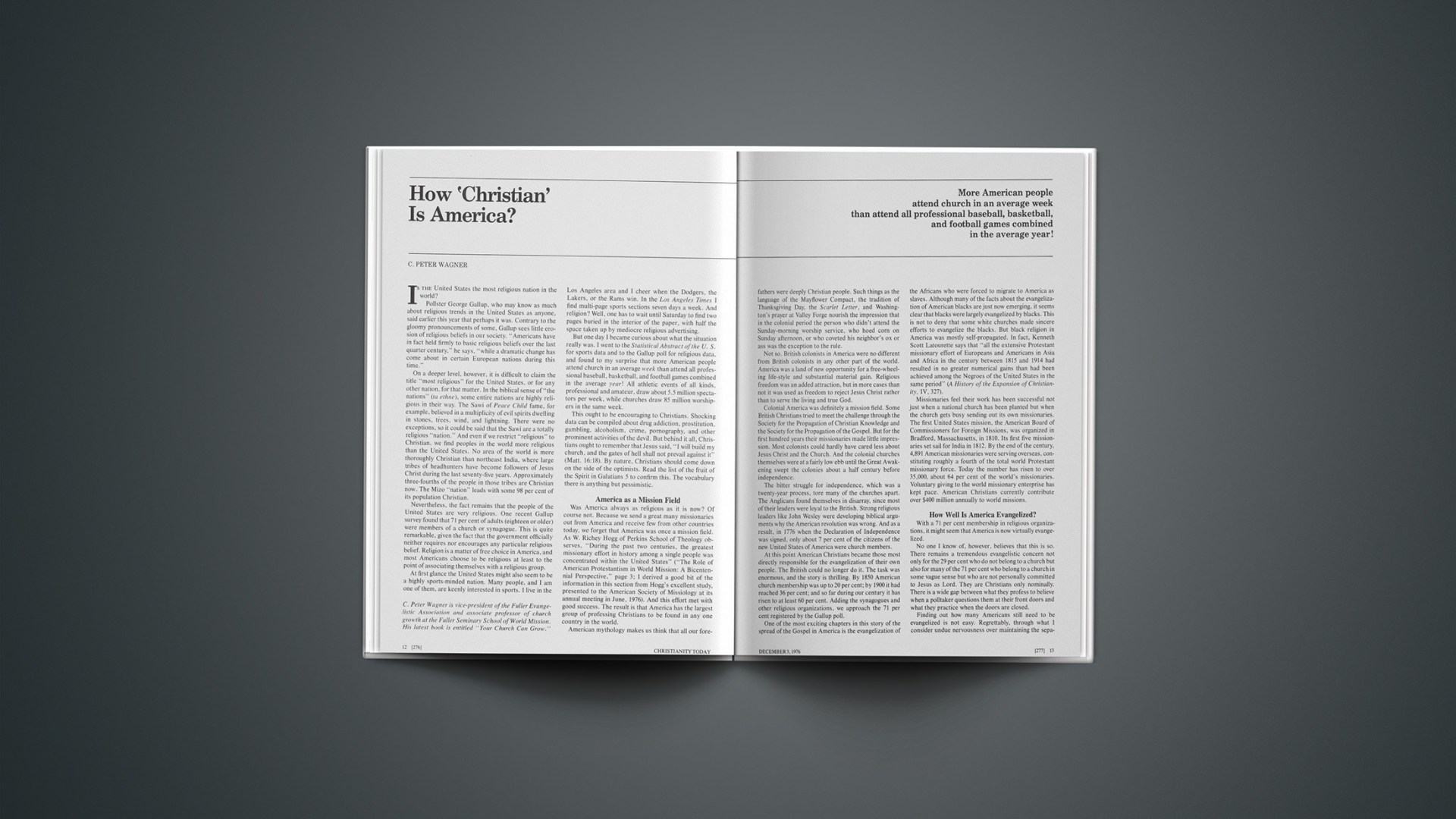What Is Evangelization?
Mission Trends No. 2, edited by Gerald H. Anderson and Thomas F. Stransky (Paulist or Eerdmans, 1975, 279 pp., $2.95 pb), is reviewed by Charles E. Hummel, director of faculty ministries, Inter-Varsity Christian Fellowship.
Evangelization is the keynote of this volume on contemporary mission trends. The first in the series featured the nature and goals of the Christian mission, while the next will deal with Third World theologies.
The volume is remarkable for its breadth of view and depth of perception. The authors of the twenty-two essays run the spectrum from evangelical Protestant and Pentecostal to Roman Catholic. Equally varied are the racial and cultural perspectives, from American and European to African, Latin American, and Asian. Most of the essays first appeared as addresses, magazine articles, or reports, rather than as theological treatises, and they are very readable. Their length ranges from one to twenty-five pages.
Amid this diversity runs a strong current of urgent concern to understand how the Gospel can be effectively proclaimed in every continent and culture. This collection of essays is not a puzzle whose pieces can be neatly fitted together to form a blueprint for action. It is more a gem with many facets, each reflecting an aspect of evangelization or its impact in a specific situation.
The writers do not focus on techniques but go to the heart of the theological and ethical issues in mission strategy. The first section, seven essays under the umbrella “Mandate and Meaning of Evangelization,” deals with evangelism, conversion, and church membership. John Stott sets the stage with a clear exposition of the biblical basis of evangelism. He shows that the Church’s mission is broader than evangelism; “mission” describes its total service, everything the Lord sent the Church into the world to do as the salt of the earth and the light of the world. Social and economic concerns are a part of this mission. A vital dimension of it is evangelism, spreading the Good News of Jesus Christ.
Paul Löffler’s exposition of conversion, the human response to evangelism, draws on Old and New Testament teaching. He affirms that this personal reorientation toward God has corporate as well as individual consequences: “There is absolutely no gap between turning to God and its realization in the personal and social spheres.”
Ecuadorian René Padilla takes American “culture-Christianity” to task for preaching man’s reconciliation with God while denying man’s reconciliation with man in certain areas of alienation. This “truncated Gospel” provides the basis for “religious clubs with a message that has no relevance to practical life in the social, the economic and the political spheres.” Padilla makes it clear that every culture tends to tame and shape the biblical message for its own comfort. But he focuses on the American version because its influence in world missions is so great. This hard-hitting essay tests the extent to which we are willing to hear such criticism and take corrective action.
The second section of nine essays is headed “Priorities and Strategies.” Especially stimulating are perspectives from India and South Africa. Samuel Rayan relates evangelism and development in the sense of liberation and humanization. “How does faith in the Crucified link up with social action, political conflict and economic development?” He shows the urgency of this question for the Church in India, where for centuries colonial missions were content “to tailor the Gospel to suit the economic and political interests of their sponsors.”
Manus Buthelezi writes from his experience of the black agony in South Africa. He believes that now is the time for the black to evangelize and humanize the white and to “discover a theological framework within which he can understand the will and love of God in Jesus Christ outside the limitations of white institutions.”
Ralph Winter’s article on crosscultural evangelism defines three kinds of evangelism in terms of cultural distance and difficulty. E-1 evangelism involves witness to a non-Christian within one’s own culture. E-2 reaches out to someone nearby with a different social status or dialect or tribal membership that constitutes a cultural barrier. E-3 evangelism involves a radically different culture with its own language and customs. E-2 and E-3 are “crosscultural” and therefore more difficult than E-1. Winter notes that four out of five non-Christians in the world today are beyond the reach of any E-1 evangelism.
The strategy for evangelism calls for special E-2 and E-3 efforts to cross cultural barriers and establish strong evangelizing churches and groups that then carry on effective evangelism at the E-1 level. This model is also valuable for evangelistic efforts in our own home communities, as we try to evangelize special groups out of our E-1 sphere. Winter’s is the most practical chapter, in itself well worth the price of the book.
A short third section deals with pluralism in the Church and the world. Emmett Carter considers problems of unity and diversity. A study document defines and relates concepts of Christian witness, common witness, religious freedom, and proselytism.
A final section of three essays gives new perspectives on other faiths and ideologies. Of special interest in view of recent developments in China is Donald MacInnis’s “A New Humanity in People’s China.” He describes the profound changes that have transformed the psychocultural identity of the Chinese people. While God is doubtless at work in the lives of individuals, “Christianity incognito will fail to reach others for conversion to Christ.… An identifiable community, the Church as the body of Christ, is needed within society at large.”
As valuable primary source material the appendix gives excerpts from documents produced by such gatherings as the WCC’s “Salvation Today” conference in Bangkok and the Lausanne Congress on World Evangelization.
The editors did well in their selection of writings for this volume. And the introduction they provide for each essay whets the reader’s appetite for the stimulating pages to follow.
What’s Coming?
Images of the Future: The Twenty-first Century and Beyond, edited by Robert Bundy (Prometheus, 1976, 239 pp., $12.95), Religion 2101 A.D., by Hiley H. Ward (Doubleday, 1975, 247 pp., $7.95), and Understanding Tomorrow, by Lyle E. Schaller (Abingdon, 1976, 144 pp., $3.95 pb), are reviewed by Carl Townsend, director, Center for the Study of the Future, Portland, Oregon.
Each of us lives in the past, the present, and the future. Our past molds and shapes us, giving us a personal history. Our rituals and liturgies are a link to the past and what has gone before us. We also live in the present, sensing and experiencing the very reality of life. The future, however, gives us hope and vision. Our dreams and destiny lie in the future.
In earlier decades there was little fear or concern about the future. Change was slow and fairly predictable. It was easy to adapt to the changing world as one grew. This is no longer true. In the last few years we have experienced an increasing rebellion against any kind of authority; an increasingly sensate and pluralistic society; a growing suspicion of institutions; a depletion of many natural resources; the “liberation” of blacks, women, youth, and homosexuals; rapidly growing unemployment and (for some) increasing leisure; and the growing influence of the computer and other forms of technology in our life. During the last year, for example, our church in Portland has changed geographic location, changed facilities, changed its organizational structure, and changed its accounting procedure to enable better tracking of a budget that has doubled in size. We have also experienced a considerably change in the membership of the church.
This “Big Revolution,” as Schaller calls it in Understanding Tomorrow, is occurring at an ever increasing rate. “The person who can grasp the nature and direction of the Big Revolution will have an enormous advantage over those who do not comprehend this concept in both understanding and in responding to the changes that are a part of the second half of the twentieth century.”
For this reason the dreams and images we hold of the future are very important. The futurist does not predict the future; he creates images and visions of various alternative futures. From these we chose, creatively participating in making the future we desire come to pass. God’s Holy Spirit, working through us, becomes the actualizing force.
Polak, writing the opening essay in Images of the Future, says we must consciously work toward creating the future we desire or else the great decisions of the future (e.g., genetic manipulation, resource management, behavior modification) will be made by someone else. If we refuse to take responsibility for the future, others will make the future—both theirs and ours. “It is not a choice between having or not having any images of the future, but between good images—worth living and dying for—and bad images, which we cannot accept without betraying ourselves.”
The remaining six parts in this volume build on the thesis developed in the first part and take as subjects the futures movement and images of the possible, images of world trends and problems, images of human progress, non-male and non-white images of social reconstruction, religious imagination and the future, and images of education and learning.
The editor, Robert Bundy, writes in his own essay that most of us are now excluded from decisions about the future. The decisions are largely made by others and sold to us by way of Madison Avenue. Although as a society we are rich in information, in most areas of our lives we experience a poverty of information because we have shifted the decisions to the specialists. This leads to a narrow perspective and a poverty of imagination in forecasting and planning. There is a real need for “people centers” in our communities (both social and religious communities) to channel information and give a wider base for decision-making.
Lester Brown and Roy Fairchild, building on this, write that education is now recognized as the primary vehicle for social change. Few problems are as challenging as that of devising an educational system adequate for our needs in the late twentieth century. Education becomes the key in informing people of the need for change and motivating the acceptance of new ideas. Learning modes will soon consist more of networks than of buildings. With terminals and microcomputers in our homes, information will be mapped to each person profiled to his or her own needs. Televised courses and newspaper courses will grow a hundredfold, and information networks to provide legal, medical, and other professional help will be expanded. (At our Center for the Study of the Future, we are already using a microcomputer to match information to requests.)
A dozen new theologies carry us from our present age to the future. In the section on religious imaging, Elise Boulding groups these into four models: the existential, the radical Christian-secularist, the signals-of-transcendence model, and the sacration model. The author gives examples of each, adding that the “work of the Christian is to extend the concept of Koinonia into the secular world, helping to build new types of communities to cut across ethnic, national, class, and other boundaries.” We witness from community, yet this community is very difficult to achieve today because we have no common myths or stories.
One difficulty with this book is in assimilating the wide variety of views expressed by writers of many nationalities and religious persuasions. The cohesion is difficult, but Bundy does an excellent job of bringing them together. An epilogue weaves a fabric of ideas from this group of notable writers.
I recommend this book to the serious student as well as to those pastors and religious leaders involved in the process of change. In many churches change is happening fast. Our worship services need to help us more in bridging the past to the future. Our myths, liturgies, and symbols give us a link to the past. We also need a sense of calling, of our mission in the future. The whole congregation needs to be involved in this imaging process. In this sense the worship experience can become a “rite of passage,” carrying us into the future with a minimum of shock.
Hiley Ward’s Religion 2101 A.D., in contrast, is written in a style that is easy to read and digest. Ward, a religion writer for the Detroit Free Press, interviewed hundreds of notables in the futures field. His opening two chapters give a panorama of what can be expected in the future: high-strength structural materials, super-duty fabrics, seven-foot television screens, telepathic sermons, behavior control, special pills for special groups of people, increased I.Q., improved healing methods from mind control, people who look the way they want with no defects and with lifetime immunization from diseases, cloning, cyborgs (people with artificial parts), and genetic manipulation. Many of these technological developments are already a reality.
At the same time, says Ward, there are new religious experiments that are just as intriguing. Biersdorf, speaking at the 1973 “Insearch: The Future of Religion in America” conference, said in his keynote speech that here and there persons and communities are already creating new patterns for the future. “They are modeling the future now, so that surveys of 1980 will record their effectiveness in changing the shape of organized religion.” These groups can be effective in creating change, even though some of them may go out of existence or continue as minority forces.
Biersdorf put together a list of two hundred groups, of which fifty-six reported in detail to the Insearch conference. These included Pentecostals, house churches, communal groups, liturgical experiments, work communes, special agencies, meditative communities, and experimental congregations. In summary, Biersdorf noted that the groups had a common denominator in that whatever their intentional goals, they were preoccupied with the realization of an intimate community. In an earlier Insearch conference, Andrew Greeley said he believes the critical question is whether organized religion is ready to accept the authentic working of the Spirit in these underground communities. We are moving away from denominational polarities. The new polarity, says Bruce Larson, is the person versus the impersonal.
From this catalogue of contemporary experiments, Ward takes us on a space-age trip to the cities of tomorrow with their super-computer gods that automate the confession (this will free the priest for more critical theological activities).
Where is the institutional church in this? The cultural crisis of our age is leading to a new affirmation of the spiritual. The saints of tomorrow will be different and could be unheralded until we can change with them. The tide has come and gone, but we find ourselves on a different shore. Schillebeeckx believes the paths around the institution will determine the shape of the church of the future. Karl Rahner believes that a general church is not possible, and that the church will be characterized by a diversity of groups. The effective spiritual tension will continue to exist with a definite change in religious language by 1990 and 2000. Elmer Towns thinks most of the main Protestant denominations face a dim future. They lack identity and a dynamic theology. Martin Marty agrees with Towns in part, adding that most denominations are remote, impersonal, and bureaucratic. The religious giants have all departed.
Worship in the future will be more of the experimental, with new rituals and liturgy. There will be new uses of music and dance. There will be new emphasis on worship in the home.
Ward includes an appendix of 134 groups that are dealing with the future (including UFO groups and those of the military-industrial establishment). Some of the addresses are dated, but the list is a good starting point for correspondence with leading futurists.
Schaller’s Understanding Tomorrow is primarily a collection of statistics and information showing current social trends and their relation to the church and the religious dimension. The primary difficulty is that Schaller’s projections are based on trend analysis, which is inadequate in itself as a method for grappling with the future.
An example of this is his third chapter, which forms the thesis of his book. Here he says that we are in a rapid revolution, moving from a survival-oriented culture to an identity-oriented society. We find more meaning and recognition as persons than as performers of a task.
I agree with Schaller that our society has, indeed, moved to an identity crisis, but this is no guarantee that we will continue to move in this direction. In fact, many futurists and economists believe we are on the threshold of moving back rapidly to a survival-oriented society, and they foresee an impending economic collapse. Trend projections, in this sense, become inaccurate, and can be dangerous, lulling us to a false sense of security. We need to envision more about where the Holy Spirit is calling us, and then work backward from the future, using trend projections only to show us how to actualize our calling.
Schaller is excellent, however, in his advice to churches that find themselves caught up in change. His writings are based on many years of consulting with churches, and here he has much to offer. His final chapter suggests that we can no longer work with simple answers. In our complex world the intuitive response is generally counter-productive. The person or community who can envision or image where it wants to go and how the vision can be brought to reality has an enormous advantage over the person or community that is without a clear sense of identity in the midst of today’s change.
Many of the trends and changes Schaller mentions are particularly important for the near future of the church. In addition, anyone who uses imaging methods (and Schaller does at times) needs to be aware of trends.
All three books have a deficiency that continues to concern me as I read the writings of most futurists. Few seem to give us much insight into the work of the Holy Spirit in the community of the future. The Holy Spirit, acting in history, is both the illuminator (giving us the vision and image) and the enabler (giving us the power to actualize the vision). Until we become more aware of this power, we can expect little redemptive change.
Briefly Noted
Two meritorious books of photographs of church buildings, suitable for Christmas giving, nicely complement each other. Holy Places of Christendom by Stewart Perowne (Oxford, 160 pp., $12.95) covers the whole of church history and focuses on the stately. There are some non-church scenes. Pioneer Churches, photographs by John deVisser, text by Harold Kalman (Norton, 192 pp., $27.50), is restricted to North America, with a different sort of stateliness. Probably most of the buildings are wooden, and the range of denominations represented is broad.
Everyone who has the four-volume Interpreter’s Dictionary of the Bible (published 1962) needs to acquire the Supplementary Volume edited by Keith Crim (Abingdon, 1,046 pp., $17.95). Preparing supplements every decade or so is an excellent idea that other reference-work publishers should consider. Of the more than 650 entries, 140 are completely new.
An expensive combination of “how to write” information (any help in this area is better than none) with data on presidents, states, countries, religions, art, and the like that are generally available in annual almanacs makes up the Quick Reference Encyclopedia (Nelson, 880 pp., $24.95).
The Catholic Encyclopedia by Robert Broderick (Nelson, 612 pp., $24.95) is a very curious offering. It comes from an evangelically controlled publisher, but there is no entry for “Evangelicalism” (nor for “Fundamentalism,” though there is one for “Jesus Movement”). There is an entry for “Franciscans” (the author studied at St. Francis Seminary) but none for “Dominicans” or “Trappists.” We are told that “current negotiations are under way for the Evangelical United Brethren to be merged with … the Methodist Church.” That merger was completed in 1968! No reference work is perfect, but …
Collegians In The Sixties
Radicals in the University, by Edward E. Ericson, Jr. (Hoover Institution Press, 1975, 281 pp., $11), is reviewed by William H. Young, professor of education, Barrington College, Barrington, Rhode Island.
This book offers a persuasive analysis of the rise and fall of the youth movement on college and university campuses in the 1960s. It traces the development of the ideology of the New Left movement from early pronouncements by the Students for Democratic Action to futile efforts to keep the radical impulse alive in the early 1970s. This study provides an intriguing insight into how this movement succeeded in capturing the imagination of so many university students and young faculty for a brief period in the last decade and why its revolutionary ideals so quickly lost their impact.
Ericson is a dean at Northwestern College, a Christian liberal arts college in Iowa. His central thesis is that contradictions inherent from the beginning in the goals of the New Left remained unresolved throughout the sixties and eventually led to its dissolution. He argues that the movement failed because its dual goals of personal and political liberation were defined in terms that produced unresolvable internal conflicts. Among the early radical leaders, a fervent desire for personal fulfillment and freedom inspired a quest for radical alternatives to existing social and political structures. Commitment to political revolution to achieve liberation for oneself and others eventually led to rigid Marxist forms of expression. Ultimately, however, radical politics proved an insufficient vehicle for integrating the hopes for personal and social freedom among young radicals. Disillusionment, bitter in-fighting, and factionalism were the inevitable outcome.
A case study of radicals in the fields of language and literature shows the two-headed character of this movement. Young teachers committed to its ideals could not reconcile their professional concerns and their political commitments. Teaching and writing about language and literature often seemed irrelevant and even inconsistent with their political radicalism. Their chief professional task involved the study and transmission of the great literary tradition of Western civilization, but their political theory led them to question this tradition and the place of the humanities in the university. In the end, these radicals chose politics over professionalism.
In a concluding essay Ericson carries his thesis one step further by viewing the radical movement as a quasi-religious phenomenon. The radicals frequently used religious metaphors to describe their experiences and motives. They sought to provide a unifying core of beliefs to govern all of life, and their quest for personal and social salvation had deep moral and spiritual dimensions. This study even shows that the radical movement took on characteristic features of sectarian religion, including heresy-hunting, proof-texting, and appeals to infallible authority. But revolutionary politics failed as a substitute religion for the same reason it failed as a movement for liberation: it could not satisfy the spiritual needs of the young radicals themselves.
The book, therefore, is of particular interest to evangelicals. They will find in it testimony to the inability of a quasi-religious political movement to satisfy the moral and spiritual impulses that originally brought it into being. The further this radicalism moved toward political activism and rigid ideology, the more alienated became its young adult adherents, whose idealism had profound spiritual roots. Ericson’s study helps the reader understand what shaped the radical movement and why its growth and demise cannot be understood in purely secular terms.
New Periodicals
The New Review of Books and Religion began in September as the successor to Review of Books and Religion and Seabury’s New Book Review. Librarians, professors, and others who are interested in serious (but not overly technical) religious books will want to see it regularly. The editor-in-chief is Iris Cully, who teaches at Lexington Seminary. Monthly, $10/year (815 Second Ave., New York. N.Y. 10017).
Theological Education Today is a quarterly replacement for Programming. First issue was in April. The scope is worldwide, and the name was changed to broaden the subject matter to include all educational methods. (It is not a news sheet.) Sponsor is the World Evangelical Fellowship, to which checks should be made; $3 airmail, $1.50 surface (address: J. E. Langlois, Les Emrais, Castel, Guernsey, U.K.).

